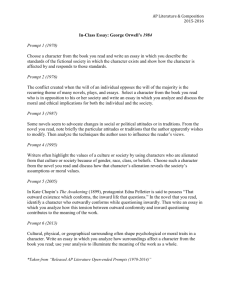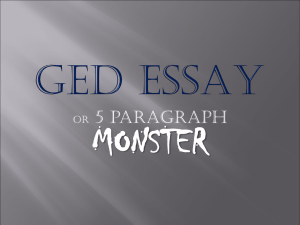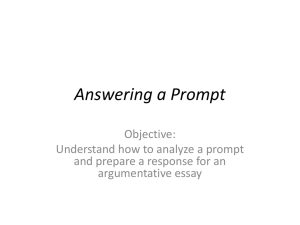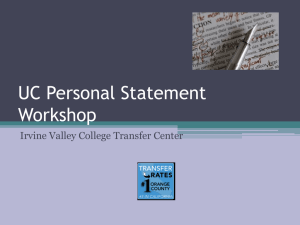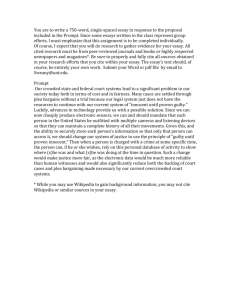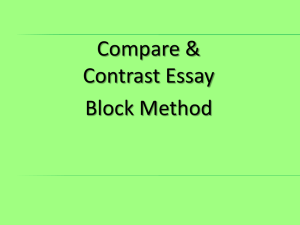Original Project - Elon University
advertisement
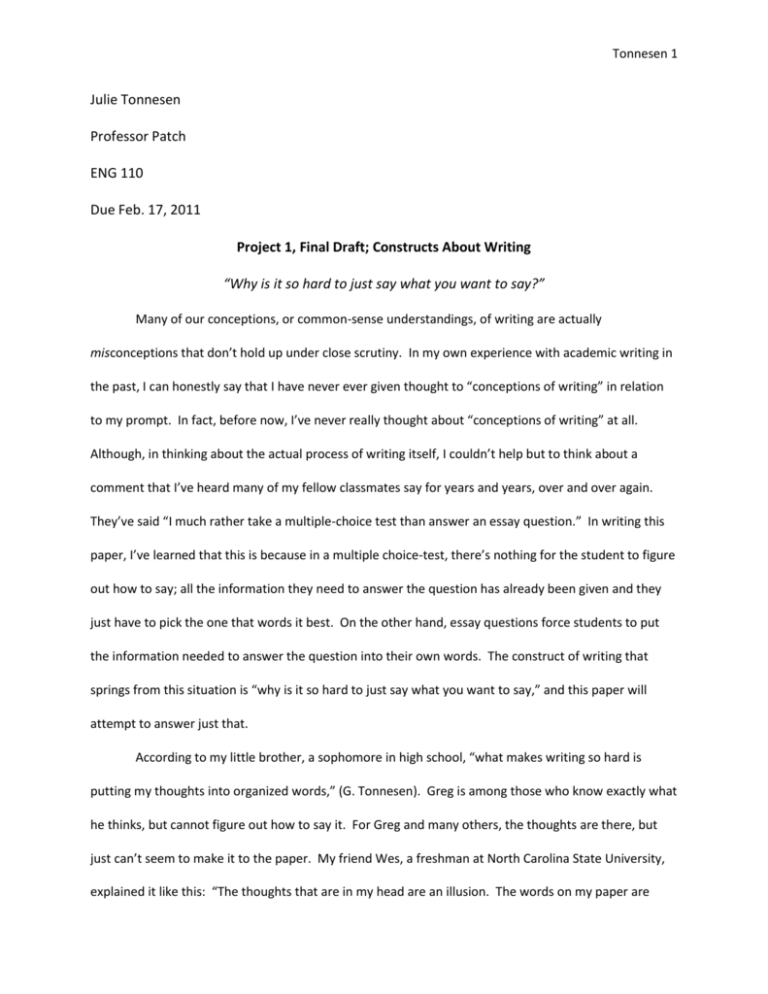
Tonnesen 1 Julie Tonnesen Professor Patch ENG 110 Due Feb. 17, 2011 Project 1, Final Draft; Constructs About Writing “Why is it so hard to just say what you want to say?” Many of our conceptions, or common-sense understandings, of writing are actually misconceptions that don’t hold up under close scrutiny. In my own experience with academic writing in the past, I can honestly say that I have never ever given thought to “conceptions of writing” in relation to my prompt. In fact, before now, I’ve never really thought about “conceptions of writing” at all. Although, in thinking about the actual process of writing itself, I couldn’t help but to think about a comment that I’ve heard many of my fellow classmates say for years and years, over and over again. They’ve said “I much rather take a multiple-choice test than answer an essay question.” In writing this paper, I’ve learned that this is because in a multiple choice-test, there’s nothing for the student to figure out how to say; all the information they need to answer the question has already been given and they just have to pick the one that words it best. On the other hand, essay questions force students to put the information needed to answer the question into their own words. The construct of writing that springs from this situation is “why is it so hard to just say what you want to say,” and this paper will attempt to answer just that. According to my little brother, a sophomore in high school, “what makes writing so hard is putting my thoughts into organized words,” (G. Tonnesen). Greg is among those who know exactly what he thinks, but cannot figure out how to say it. For Greg and many others, the thoughts are there, but just can’t seem to make it to the paper. My friend Wes, a freshman at North Carolina State University, explained it like this: “The thoughts that are in my head are an illusion. The words on my paper are Tonnesen 2 concrete. Taking illusive thoughts and translating them into concrete words is where the difficulty lies” (McNeely). While some would say that Wes and Greg are suffering from writer’s block, or possibly a learning disability, Maria Rey defines it as something completely different, and in my opinion, much more accurate. Due to her high school experiences, she came to the conclusion that she couldn’t figure out how to articulate her thoughts because there were so many limits placed on her assignments. She and many other students “felt no need to elaborate on their thoughts or produce well-thought-out pieces,” (Rey, 273). I believe that this is what Greg and many other students have to blame for their writing difficulties; they’re focused on the constraints. For students in their situation, constraints are the little details that allocate what can and cannot be said, and how it can and cannot be said. Greg went on to tell me that many times when he is writing, he gets too hung up on making sure that want he wants to say fits within the guidelines of the prompt, as opposed to developing and supporting his arguments (G. Tonnesen). I found that this is a recurring problem at every level of education. When I asked my little sister, Katie, who is in seventh grade, what is the first thing she does when she receives a prompt, she said “I think to myself, ‘how can I write about this?’” After listening to her talk about typical prompts she is assigned, and how she goes about writing them, I think what she means by “How can I write about this?” is “How can I make what I want to say right, according to my prompt?” (K. Tonnesen). Both Greg and Katie’s comments about writing got at the same point: prompts can be so overwhelming that their constraints become more important to students than the actual question, itself. The comments from my siblings, in addition to Maria Rey’s essay, leave me with no doubts that one of the main reasons that students have such a hard time figuring out “how to say it” is because they’re focusing on the wrong thing. The reality is that they probably know exactly what they want to say, but when they see the intricate details of the prompt in front of them, they second-guess their Tonnesen 3 original thoughts. In turn, they weaken the conciseness of their statement, which weakens their argument and decreases their grade, which is what they were afraid of in the first place. Unlike Rey, Mike Rose believes that “writer’s block” can be a very challenging hurdle for students to jump when they are writing for academic purposes. He defines writer’s block as a complex problem that encompasses several different elements of writing including, but not limited to, constraints, rhetorical situation, and preconceived notions. Mirroring what Rey said in her essay, Rose believes that many have trouble with writer’s block because they are more concerned with their constraints than they are on their topic. The difference with Rey and Rose is that Rose takes it one step further, and goes to say that it’s not just assignments’ specifications that give writers trouble; it’s also preconceived notions of what good writing includes. These notions range from having to include an opening paragraph that quickly grabs the readers’ attention, having to stick to an original plan, and having to create a typical five paragraph essay that features an introduction, three body paragraphs, and a conclusion (Rose, 244-248). I would agree that a majority of students, particularly those who have not been introduced to many different styles of writing, can easily get caught up in focusing on these notions as opposed to just saying what they need to say. Of all the notions that Rose lists as the most common, I have found that sticking to an original plan, and making sure that an essay fits a specific format are the most common concerns among students. For example, Katie told me that to plan her essays, she constructs a web that flows from the introduction all the way down to the conclusion. She went on to say that many times, she comes up with new ideas while she is writing, but before she will add them to her paper, she references her web to see if it will fit with the outline she has already designed. “If I like it [one of her new ideas] better than something on the web, then I’ll replace it; but if I don’t like it more than one of my other thoughts, I just forget about it” (K. Tonnesen). What clearer piece of evidence is needed to infer that many students who have a hard time articulating their thoughts struggle because they are Tonnesen 4 more concerned with preconceived notions than they are with the topic itself? It makes me sad to think that Katie doesn’t feel like she can truly express herself unless her thoughts coincide with a limiting map that her teacher expects to be helpful for all students. Taking a totally different side, Wes said that he never really plans or outlines an essay when he is given a prompt. “I look at the prompt and then decide what my stance is going to be. The specific points I want to make don’t develop until I actually start writing,” he said (McNeely). While Wes and Katie have very different approaches to writing an essay, I think their general struggles are the same, only on different levels; they both want to please the person who assigned the prompt. Katie tends to be more concerned with adequately answering the question posed in the prompt and making sure that she doesn’t have to go outside her “web of safety” in order to do so. Wes, on the other hand, said that he always tries to take a stance that his professor would agree with because of his or her own beliefs, or because he has provided ample amounts of evidence to support his own argument. While Greg didn’t articulate his planning process quite as eloquently as Wes or Katie, I believe that he, too, struggles with the translation of his thoughts to words because he is more focused on what he is expected to say as opposed to what he wants to say. None of them are concerned with answering their prompt honestly nor are they comfortable with saying what they actually think. At this point, I could argue that the reason students have trouble “knowing how to say it” is because teachers and professors assign poor prompts with too many constraints that limit a student’s thinking process as opposed to enhancing it. I’m afraid that this argument would require another 10 or 20 pages, so instead I think it’s more appropriate to suggest strategies that can ease the translation from illustrious to concrete. Throughout the course of my educational career, I have found that the following strategies have helped me to conquer tough writing assignments, and a majority of these strategies have been validated by some of the experts featured in “Writing About Writing.” First of all, students need to remember Tonnesen 5 that what they think does matter, and whether or not they can see it, their honest thoughts are what their teachers want to see. Secondly, they need to write down whatever comes to mind, and not be concerned about the constraints during the writing process. A long string of jumbled thoughts and words is much easier to refine than nothing at all. Going off of this, they need to remember that revision is one of the most important parts of the writing process; they’re not expected to (and probably won’t) get it right the first time the thought makes its way onto the paper. During the revision process, Katie can then think about whether or not her words fit into her web, and Greg can think about whether or not he’s answering the prompt. In addition, Wes said that the best advice he ever received about writing was to break it up and look at it in small chunks. “I just take it sentence by sentence. Instead of thinking about the blank page in front of me, I write a sentence. And then I write another. And before long, there’s no more blank page which is one less thing for me to worry about” (McNeely). Allegra Goodman reminds writers that the final and most important thing that they must think about when they are writing is this; writing is sacred. Not only is it sacred, but you have to treat it like it’s sacred. If you don’t respect and love your work, then why would anyone else (Goodman, 309)? As a result of this project, I have learned more about writing than I ever expected to learn. When I began planning this essay, I thought my construct was going to focus on what made writing to get a good grade so hard. But, I learned that for many, writing is hard because they have trouble articulating their thoughts. Then I learned that they have trouble articulating their thoughts because they’re too focused on constraints and preconceived notions. This was followed by the newly acquired knowledge that they’re too focused on constraints and preconceived notions because they want to please their teachers. Finally, I learned that they want to please their teachers because they want to get a good grade, which was their original concern in the first place. Now I know that many students have trouble “knowing how to say it” because they have the writing process all wrong; they want to be critical Tonnesen 6 of a brainstorm which gets them absolutely nowhere. It’s like tying a dog to a tree and then throwing a Frisbee in the opposite direction and expecting him to catch it; he’s never going to catch it as long as the leash is there. The good news is that by looking at writing as a step-by-step process, you can ditch the leash and catch the Frisbee all you want. Tonnesen 7 Works Cited Goodman, Allegra. “Calming the Inner Critic and Getting to Work.” Writing About Writing. Ed. Doug Downs and Elizabeth Wardle. Boston: Bedford/St. Martins, 2011. 308-310. Print. McNeely, Wesley R. Telephone Interview. 14 Feb. 2011. Rey, Maria. “Letter to West Port High School’s English Department.” Writing About Writing. Ed. Doug Downs and Elizabeth Wardle. Boston: Bedford/St. Martins, 2011. 271-277. Print. Rose, Mike. “Rigid Rules, Inflexible Plans, and the Stifling of Language: A Cognitive Analysis of Writer’s Block.” Writing About Writing. Ed. Doug Downs and Elizabeth Wardle. Boston: Bedford/St. Martins, 2011. 236-249. Print. Tonnesen, Gregory T. Telephone Interview. 14 Feb. 2011. Tonnesen, Katherine, L. Telephone Interview. 14 Feb. 2011.

